Transport of MAESTRO from
downtown to the MMT
Last update: June 7, 2013
DOC PDF
-
The MMTO staff transports MAESTRO from downtown to the MMT.
Coordination with Grant Williams and the
mountain staff, especially Ricardo Ortiz, is essential.
-
Lower the spectrograph to the cart, instructions are HERE.
-
The cart and spectrograph fit in the Steward freight elevator.
-
The spectrograph is transported in the MMTO's air-ride truck, usually
driven by Tom Oldham.
-
The spectrograph and cart are secured with straps in the back of the
truck, and there is plenty of space for other equipment.
Important Notes:
1. TEMPERATURE Monitoring.
The spectrograph camera/collimator has a large, irreplacable calcium
fluoride lens which is sensitive to mechanical and thermal shock, that
is, it can shatter if subjected to steep temperature gradients or fast
temperature changes (see e.g. Hilyard Proc. SPIE 4411, Large Lenses and
Prisms, 130 (February 7, 2002); doi:10.1117/12.454880). The
calcium fluoride lens is protected by a large cell, deep in the
spectrograph, which has a large thermal inertia. But it is
important to anticipate potential temperature changes during transport.
The ambient temperature, and the temperature of the CaFl cell can be
monitored with the radio thermometer, attached to a clip board, to log
temperatures.
2. DIRT. The
road to the mountain is dirty. The air-ride truck is enclosed,
but the spectrograph should be covered with plastic. Any
equipment should be transported inside trucks, or
carefully covered with plastic.
3. STRESS OIL RELIEF VALVE.
The CaFl is in a triplet which is oiled. In order that the oil
doesn't leak through the cell O-rings and seals, a tube has been
attached to the outside of the spectrograph, with a flexible rubber
membrane to allow pressure equalization. There is a spigot that
allows
the oil system to be shut off if the spectrograph is tipped. The spigot should be OPEN when the
spectrograph is transported up the mountain, since the change in
atmospheric pressure may cause damage to the cell otherwise. See this page for further instructions.
Pictures: More pictures are located HERE.
This is the remote temperature monitor. The sensor is taped to
the CaFl lens cell. The clip board should be stored in the
MAESTRO cabinet when not in use.
